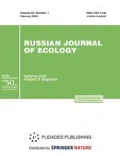Abstract
The spatiotemporal dynamics of forest-tundra communities in the 20th century have been studied in the timberline ecotone of the Polar Urals. Maps reflecting the distribution of different types of forest-tundra communities have been made, and data on the morphological and age structure of tree stands have been obtained for three time sections (the mid-1910s, 1960s, and 2000s). They show that open and closed forests have markedly expanded due to natural afforestation of the tundra and increase in the density and productivity of existing forest stands. The unidirectional pattern of plant community transition (from the tundra to closed forests) and meteorological data provide evidence that this transition has been conditioned by climate warming and increasing humidity recorded during the past 90 years.
Similar content being viewed by others
REFERENCES
Bugmann, H. and Pfister, C., Impacts of Interannual Climate Variability on Past and Future Forest Composition, Reg. Environ. Change, 2000, no. 1, pp. 112–125.
Climate Change 2001: Synthesis Report. Contribution of Working Groups I, II, and III to the Third Assessment Report of the Intergovernmental Panel on Climate Change, Watson, R.T., Ed., Geneva: WMO-UNEP, 2003.
Gorchakovskii, P.L., Rastitel’nyi mir vysokogornogo Urala (The Plant World of the High-Mountain Urals), Moscow: Nauka, 1975.
Holtmeier, F.-K., Mountain Timberlines. Ecology, Patchiness, and Dynamics, Dordrecht: Kluwer, 2003.
Körner, Ch., Alpine Plant Life, Berlin: Springer, 1999.
Kullman, L., Dynamics of Altitudinal Tree-Limits in Sweden: A Review, Norsk. Geografisk Tidsskrift., 1990, vol. 44, pp. 103–116.
Shiyatov, S.G., Age Structure and Tree Stand Formation in Open Larch Forests at the Timberline in the Sob River Basin (the Polar Urals), Geografiya i dinamika rastitel’nogo pokrova (Plant Cover Geography and Dynamics): Tr. Inst. Biol. Ural. Fil. Akad. Nauk SSSR, 1965, no. 42, pp. 81–96.
Shiyatov, S.G., Time of Dispersal of Siberian Larch Seeds in the Northwestern Part of Species Range and the Role of This Factor in Forest-Tundra Interactions, Voprosy fiziologii i geobotaniki (Problems in Physiology and Geobotany): Zap. Sverdlovsk. Otd. Vses. Bot. O-va, 1966, no. 4, pp. 109–113.
Shiyatov, S.G., Dendrokhronologiya verkhnei granitsy lesa na Urale (Dendrochronology of the Timberline in the Urals), Moscow: Nauka, 1986.
Shiyatov, S.G., Rates of Change in the Upper Treeline Ecotone in Polar Ural Mountains, PAGES News, 2003, vol. 11, no.1, pp. 8–10.
Shiyatov, S G., Mazepa, V. S., and Chekhlov, O. Yu., Climate Change and Dynamics of Forest-Tundra Ecosystems in the Polar Urals in the 20th Century, Nauch. Vestn., 2002, no. 11, pp. 28–35.
Vaganov, E.A., Shiyatov, S.G., Hantemirov, R.M., and Naurzbaev, M.M., Variation of Summer Air Temperature at High Northern Latitudes over the Past 15 Centuries: Comparative Analysis of Data Derived from Tree Rings and Ice Cores, Dokl. Ross. Akad. Nauk, 1998, vol. 358, no.5, pp. 681–684.
Author information
Authors and Affiliations
Additional information
Translated from Ekologiya, No. 2, 2005, pp. 83–90.
Original Russian Text Copyright © 2005 by Shiyatov, Terent’ev, Fomin.
Rights and permissions
About this article
Cite this article
Shiyatov, S.G., Terent’ev, M.M. & Fomin, V.V. Spatiotemporal dynamics of forest-tundra communities in the polar urals. Russ J Ecol 36, 69–75 (2005). https://doi.org/10.1007/s11184-005-0051-9
Received:
Issue Date:
DOI: https://doi.org/10.1007/s11184-005-0051-9




